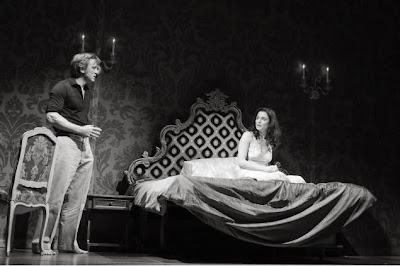 that is hoovering up fish populations, including shrimp and ecologically important parrotfish that destroy algae, all along the Atlantic Coast. Surely, the voracious Lionfish deserves to be caught and eaten in restaurants, but so far Norman’s Cay is about the only restaurant brave enough to try. Theirs comes from Nassau.
that is hoovering up fish populations, including shrimp and ecologically important parrotfish that destroy algae, all along the Atlantic Coast. Surely, the voracious Lionfish deserves to be caught and eaten in restaurants, but so far Norman’s Cay is about the only restaurant brave enough to try. Theirs comes from Nassau.Perhaps because it is wildlife, not a farmed fish, it tastes wild—and like a cross between grouper and red snapper. Norman’s Cay does fried Lionfish tacos garnished with guacamole and slaw. The whole fish is presented stunningly, surrounded by leafy greens and chunks of lime. It is beautiful to behold: the handsome pterodactyl head rests on a pedestal of molded peas and rice.
Coconut Shrimp with mango chutney is probably a classic there. However, we started in stride with tender and delicious Conch Fritters served with three sauces and quaffed a stylish cocktail called the Midnight Run: tequila, Licor 43, lime and bitters. Then, salad with Bahamian Christophine (also known as Chayote, between a fruit and a vegetable) shaved onto Valencia oranges, hearts of palm, and avocado, in a sharp vinaigrette. Our much-anticipated Lionfish experience began with senses awakened and tingling.
It is admirable what Norman’s Cay is doing for the planet, and there’s more than a little sense of adventure here. A1966 Cessna Skyhawk, purchased from Craigslist in Dayton, Ohio and driven east, hovers overhead. We felt like we were in the Bahamas even though it was cold outside.
 Burlesque is going through a renaissance that is pro-woman, unpredictable, and very funny. For instance, the Lower East Side was a testing ground for world-class performer Narcissister. We saw her groundbreaking Marie Antoinette routine a few years ago at the former Corio Supper Club.
Burlesque is going through a renaissance that is pro-woman, unpredictable, and very funny. For instance, the Lower East Side was a testing ground for world-class performer Narcissister. We saw her groundbreaking Marie Antoinette routine a few years ago at the former Corio Supper Club.One hot burlesque venue is Le Poisson Rouge, a little further north. The Box is late-night in every sense of the word. The Slipper Room and Nurse Bettie present classy and classic burlesque in midweek as well as weekend shows. Speaking of funny, Moonwork, pop-up stand-up comedy with beer served, is back up and running at Clemente Soto Velez Cultural Center.
The arty cabaret entertainment we have just recommended is witty and decadent in an almost wholesome way, but we’ve never found the food served to be anything exciting. Norman’s Cay is open some nights till 4 a.m., so you can begin or end your burlesque evening there.





























